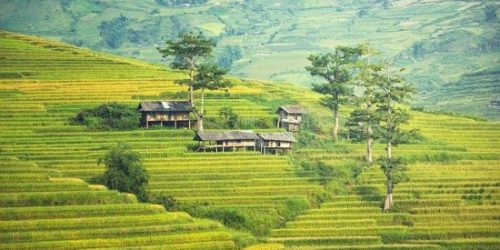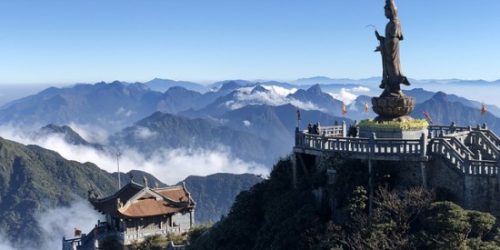Menu
A place of verdant rice terraces and colorful garments, Sapa is the most recognizable name in Vietnam’s northern tourist routes. The lively town is perched dramatically on a the western edge of a high plateau, facing the hazy blue peak of Vietnam’s highest mountain, the Fan Si Pan. The town is surrounded by numerous ethnic minority villages, particularly the Red Dao and Black Hmong, undoubtedly the region’s highlight. Established as a French hill station in the early 20th century, Sapa’s refreshing climate and almost alpine landscape have turned it into a popular destination for foreign and domestic visitors alike. Sapa is also known as one of the few places in the country where it snows, though rarely. Activities here go from trekking with local hill tribes and experiencing the local culture of the “mountain people” to conquering Fan Si Pan mountain, also known as The Roof of Indochina. For a taste of authentic mountain life we recommend staying with a local Hmong family in their humble abode. A great opportunity to learn about their day to day and perspectives on life, as well as how to make a couple local delicacies if you’re inclined to help in the kitchen.
It is believed that rice began to be cultivated in Lao Cai province in the 15th century and since then it has remained a tradition for the ethnic minorities in this area. The views of these terraces are spectacular, numerous steps that adapt to the shape of the mountains and the Muong Hoa valley. Curiously, valley possesses the rice terrace having the most steps with 121. It is best to go during harvest season, between July and September, although it usually coincides with the rainy season.

Walking southeast from Sapa along the road, we find ourselves face to face with a spectacular valley of terraced rice fields and dotted with quaint villages. Muong Hoa Valley is a paradise for trekking lovers. Depending on the time of year, you’ll be lucky enough to enjoy wonderful views over the rice terraces. Descending from Sapa you will pass several villages popular for treks, such as Ta Van, Lao Chai and Ban Ho.
Located in San Sa Ho Commune with 4km to the Northwest of Sapa Town, Love Waterfall is a must-see. The stream that feeds it starts from the peak of Fansipan Mountain. After a short ride to the entrance of the waterfall a Wizard of Oz-like paved path will lead you straight to it. The scenery along the way gets more and more beautiful, passing through the mystical Golden Stream, and ending with the majestic 100 meters tall Love Waterfall.
Trek to Mount Fansipan the Roof of Indochina with a local Hmong guide. This is an activity for experienced trekkers who ambition conquering the highest peak in the Indochinese peninsula. As you hike enjoy the mountain’s rich ecosystem, with 2,024 floral varieties and 327 faunal species. The challenging ascent and descent takes around 7-8 hours. Arrive at the 3,143m summit around noon and celebrate your victory with a picnic lunch above the clouds. For those short on time there is a faster way to get to the peak. A controversial cable car is recent addition, going all the way to a massive temple complex built atop the mountain and connected to the center of Sapa through a scenic funicular train ride.

Stay outside the tourist hub of Sapa in more simple comfort at a local homestay. There are some excellent lodges and homestays in the villages surrounding Sapa, where you’ll find individual bungalows with private balconies overlooking verdant valleys. Set among the rice terraces, you’re likely to brush shoulders with farmers and other local people as they go about their daily lives.